There are numerous amounts of soils present on the surface of earth each containing soil particles of different sizes, shapes and composition. If we classify and categorize soils, it will be convenient for us to study them.
We arrange the soils into different groups such that soils in a particular group have similar behaviour. This arranging of soils is called classification system of soil.

Any soil classification system must provide us the information about the expected engineering properties of a soil. It works as a language of communication between engineers. Classification is done so as to convey the same meaning universally. An engineer in one country classifies a soil as SW then another engineer in some other country should be able to understand what kind of soil the other engineer is talking about.
Of course we need to do a detailed soil investigation and testing for the complete knowledge of engineering properties of soil but a classification system provides an idea about soil’s engineering behaviour.
Any such classification should be simple to use and should have limited number of groups.
Generally we classify soils as cohesionless and cohesive or coarse-grained and fine-grained.
But these terms are too general and they certainly do not classify a soil when it is a mixture of different soils grains in different proportions.
Soil grain size has a great influence on the behaviour of soils. So most soil classification methods use particle size as a basis to classify the soils in groups.
We generally classify the soils based on particle size into four broad groups.
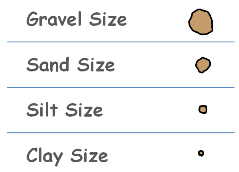
Gravel sized particles being the largest and clay sized being the smallest.
Do notice that we have written Silt size and Clay size, not only the Silt and Clay because these are the range of sizes not the actual soils Silt and Clay which exhibit properties of plasticity and cohesion.

Not all the clay sized particles are clay particles.
A big rock boulder has some rock mineral composition which is different from clay minerals. Such big rocks because of weathering transforms into smaller particles. Their size may become as small as clay particles. But such particles do not exhibit plasticity as they do not contain clay minerals and certainly are not clay but definitely clay-sized particles.
Clearly we noticed a system of soil classification purely based on particle size may be misleading, particularly for fine grained soils as their behaviour depends on plasticity characteristics, not on their particle size.
But we must keep in mind that for coarse-grained soils their particle size is of great value as their behaviour primarily depends upon it.
These are some classification systems based on particle size only.
1. MIT System
2. International Classification System
3. US Bureau of Soils Classification
Textural Classification
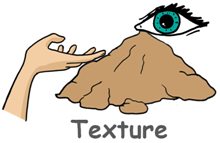 Soils are also classified based on their texture. Texture of a soil means how a soil visually appears and feels. Texture is influenced by the size, shape and gradation of soil particles in a soil.
Soils are also classified based on their texture. Texture of a soil means how a soil visually appears and feels. Texture is influenced by the size, shape and gradation of soil particles in a soil.
A triangular representation of Textural Classification System was suggested by US Bureau of Public Roads. In this system the term texture is used to express the percentage of the three constituents of the soil, Sand, Silt and Clay on the three sides of an equilateral triangle.
This system assumes that the soil does not contain the particles of size larger than sand.
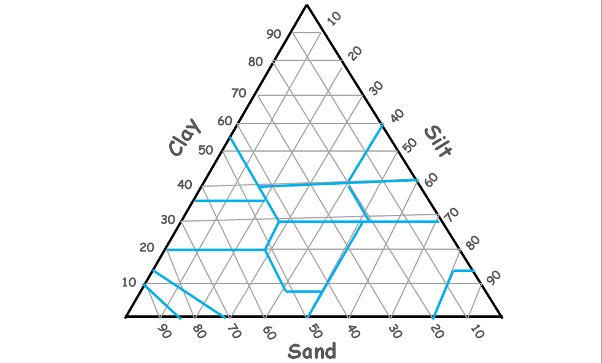
This equilateral triangle is divided into 12 zones; each zone indicates a type of soil. If we know the percentages of sand, clay, and silt in our soil sample, we can use this triangle to know our soil type out of these twelve soil types classified in the triangle.
But this system also does not takes into account the plasticity and consistency properties which are important when it comes to the fine-grained soils.
Two classification systems USCS and AASHTO are adopted by US engineering agencies and the State Departments. Other countries including India, has also adopted the USCS with minor modifications.
AASHTO Classification System
AASHTO stands for American Association of State Highway and Transportation Official (AASHTO) Classification System. It is particularly useful for classifying soils for highways.
This system classifies both coarse-grained and fine-grained soils using both particles size analysis and plasticity characteristics of soil which makes it a complete classification system.
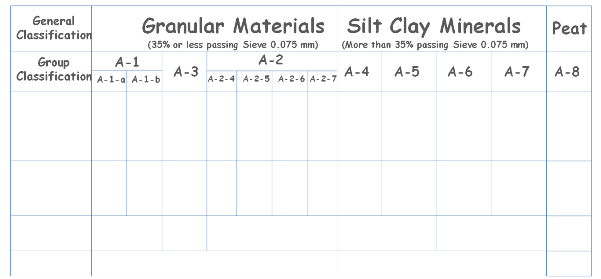
In this system soils are divided into 7 types designated as A-1 to A-7 based on their relative expected quality for road embankments, sub-grades and bases. Some of the groups are divided into subgroups. Soils within each group are evaluated according to the Group Index calculated from this empirical formula:
![]()
In general the greater the GI value the less desirable a soil is for highway construction within that subgroup.
Likewise a soil with lower number, say A-1, is more suitable for the highway material than A-4.
In AASHTO System initially there was no place for organic soil so additional group A-8 was introduced for peat or muck.
Unified Soil Classification System
It was first developed by Casagrande and later it was modified by Bureau of Reclamation and the Corps of Engineers of the USA. This system has also been adopted by American Society of Testing Materials, ASTM. It is the most popular system for use in all types of engineering problems involving soil.
This system identifies soils primarily as coarse-grained, fine-grained and highly organic.

Coarse-grained soils are classified on the basis of their grain-size distribution and the fine-grained soils, whose behaviour is controlled by plasticity, are classified on the basis of their plasticity characteristics.
According to this system, coarse-grained soils are those which when sieved, more than 50 % of their mass is retained on 0.075 mm sieve. It means more than 50% of the soil mass contains particles which are larger than 0.075 mm could not pass the 0.075 mm sieve.

If more than 50 % of this soil material passes through this sieve then the soil is classified as fine-grained soil. This soil will contain more than 50% of its soil mass made up of particles which are smaller than 0.075 mm.

These are some symbols used in the system to classify the soils.
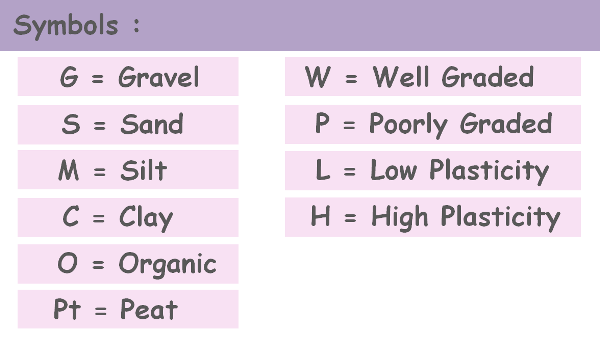
Coarse-soils are further divided into two categories.
 We further sieve our obtained coarse grained soils part using 4.75 mm sieve. This sieve has larger openings than that of which used earlier. What we are trying to do is to separate coarser part of the coarse grained soil from the finer part.
We further sieve our obtained coarse grained soils part using 4.75 mm sieve. This sieve has larger openings than that of which used earlier. What we are trying to do is to separate coarser part of the coarse grained soil from the finer part.
If more than 50 % of this coarser fraction of soil is retained on this 4.75 mm sieve then soil is designated as gravels and is denoted with letter G.
And if more than 50 % of coarser fraction of soil passes through this sieve soil is called sand and is denoted with letter S.
A soil labelled as Gravel has more than 50 % of coarse-grained particles which may also contain some percentage of sand particles and some of fines.
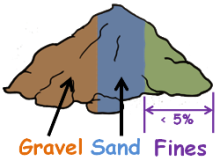 If the percentage of these fines in this Gravelly soil is less than 5 % and if the soil is well-Graded, that is soil contains all kinds of soil particles, then it is classified as well-graded Gravel and it represented by symbol GW.
If the percentage of these fines in this Gravelly soil is less than 5 % and if the soil is well-Graded, that is soil contains all kinds of soil particles, then it is classified as well-graded Gravel and it represented by symbol GW.
If the soil is poorly graded then it is poorly graded Gravel with the symbol GP.
Similarly SW and SP go for the sand.
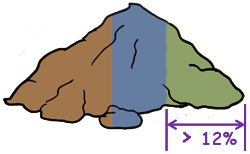
Now if the percentage of the fines in soil is greater than 12 %, and if it is gravel soil and contains silt as its fines, it is designated as GM. G for Gravel and M for silt.
GC if the fines are clay.
SM if soil is sand and contains fines of silt and SC if sand contains fines of clays.

If the percentage of the fines in coarse soils is in between 5 to 12 % then we use dual symbols to represent them.
A well graded gravel having 8% silt content is represented as GW-GM.
Similarly for poorly graded sand having 9 % clay content the symbol will be SP-SC.
It was the classification of coarse-grained soils, now we look into classification of fine-grained soils. Fine-grained soils are divided on the basis of their liquid limit and plasticity properties.
Casagrande plotted a Plasticity Chart, a graph between plasticity index of soil and its liquid limit.
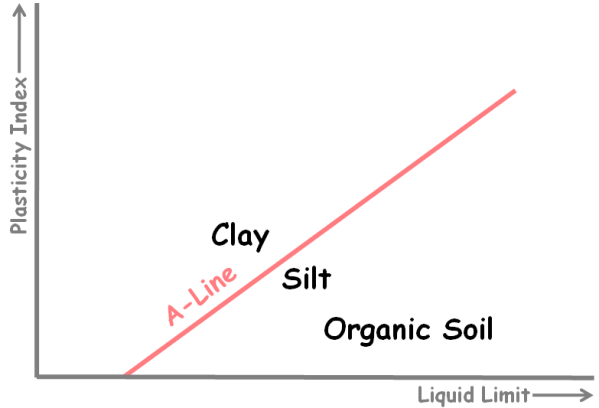
It was plotted from the experimental results of soils collected from different parts of the world. He separated clay, silts and organic soils using a graph he called A-Line.
Equation of this A-Line is given as
Ip = 0.73(wL – 20).
Clay soils sit above the A-Line as they have high value of plasticity index because of their clay minerals present in them, where as silts and organic soils lies below this A-Line.
Unified Classification System classifies fine-grained soils in two categories as soils having liquid limit less than 50 % and soils having liquid limit greater than 50 %.
So in the graph we plot a vertical line at liquid limit of 50 %.
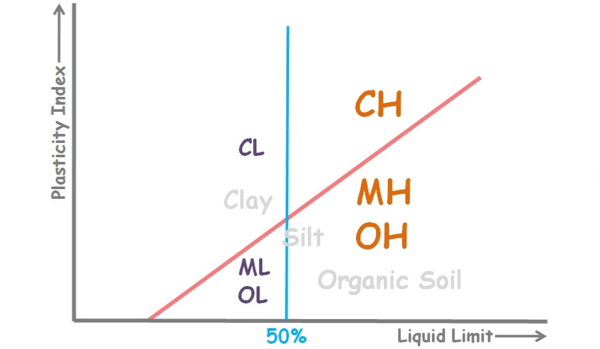
According to this system fine-grained soils lying to the right of this line have high liquid limit and are represented by symbol H. If the Soil in this part is Clay then symbol used will be CH. If it is Silt then MH and for organic soil it is OH.
Soils lying to the left of this 50% line have low value of liquid limit so they are represented by symbol L. Soils in this part described similarly CL, ML and OL.
The A-line already separates clays from silt and organic soil, now to distinguish between the silt which is inorganic soil and organic soils we use oven-drying.
We note down the soil’s liquid limit before and after oven-drying. If oven-dying decreases the liquid limit of soil by 30% or more the soil is organic and will have symbols OL or OH. And if the decrease in the liquid limit is less than 30% soil is inorganic and symbols will be ML or MH.

A U-Line is also defined as the upper limit of the correlation between plasticity index and liquid limit of the soil.
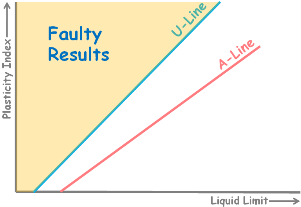
If the test results of soils fall above the U-line then results are considered faulty and experiment should be repeated.
Equation of the U-Line is given as
Ip = 0.9(wL – 8)
It was the classification of coarse-grained soils,
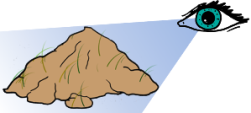 Lastly the third category unified system defines is highly organic soils. We can identify them by simply looking at them. These soils are termed as peat and are designated by the symbol Pt. These soils are not subdivided.
Lastly the third category unified system defines is highly organic soils. We can identify them by simply looking at them. These soils are termed as peat and are designated by the symbol Pt. These soils are not subdivided.
And now we can complete our Unified Soil Classification System chart.
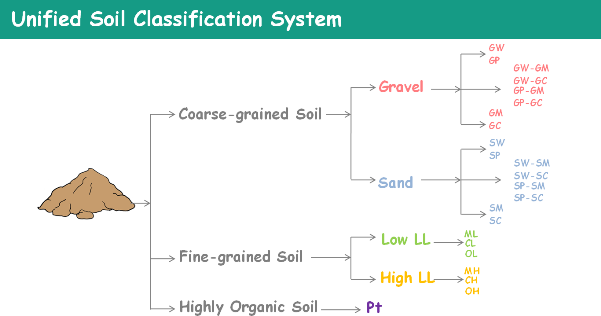
Symbols used in Unified Soil Classification system are more descriptive and are more easily remembered. This classification system has also been adopted by Bureau of Indian Standards, making the Indian Standard Soil Classification System.
Indian Standard Soil Classification System
ISSCS is in many respects similar to Unified Soil Classification System. There is one basic modification which is in the classification of fine-grained soils.
In Indian classification system fine-grained soils are divided into three categories of low, medium and high liquid limit instead of only two categories of low and high liquid limit in USC System.
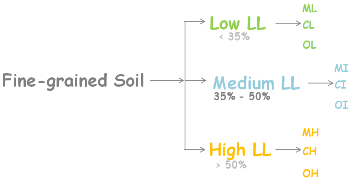
Medium category is defined between liquid limit 35 to 50%. So in the graph another vertical line at liquid limit 35% can be drawn and soils falling in this region are denoted by symbol I, such as CI, MI and OI.
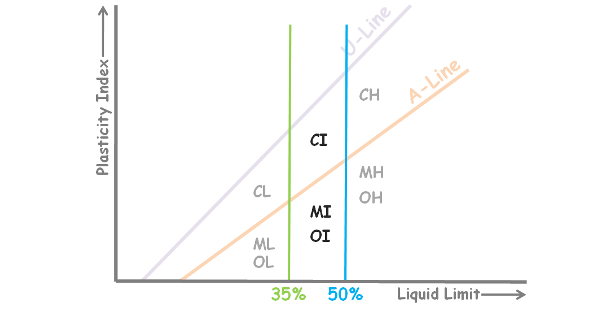
The classification criterion for coarse-grained soils is the same as in the Unified System. It has similar naming processes.
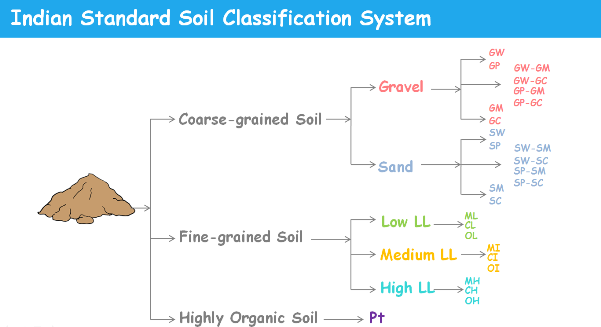
The division of soil fractions purely on the basis of grain size can be shown as this.

Soil particles of size greater than 300 mm are called boulders
particles between 80 mm and 300 mm are called cobbles.
Gravel is defined between 80 mm to 4.75 mm
Sand ranges from 0.075 mm to 4.75 mm
Silts particles have size between 0.075 mm and 0.002 mm
And clay particles are of size below 0.002mm or 2 micron.






